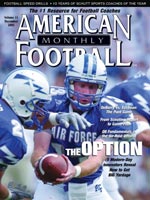AMERICAN FOOTBALL MONTHLY THE #1 RESOURCE FOR FOOTBALL COACHES
Article CategoriesAFM Magazine
|
Point-CounterpointPunting Vs. Blocking the PuntAir Forse Academy AF Vs. AP Austin Peay State University by: David Purdum © More from this issue There is no need for punt coverage, if the punt is blocked. “A blocked kick can turn the momentum of the game more than anything else,” said Air Force legend Fisher DeBerry. “It’s won a lot of football games for us and created some field position for us.” Yet, more and more coaches, including DeBerry, are utilizing the “Shield Punt,” which, admittedly, sacrifices protection for coverage. “There’s been some kicks blocked if the shield breaks down,” DeBerry said. “If you do it right though, you should be able to protect the punter and yet, at the same time, you should be able to get excellent return coverage.” “I’m not a big proponent of it,” said Austin Peay Defensive Coordinator/Special Teams Coach Granville Eastman of the punt formation in which a three-man “shield” is positioned a f....The full article can only be seen by subscribers. Subscribe today!
|
|
|||||||
| HOME |
MAGAZINE |
SUBSCRIBE | ONLINE COLUMNISTS | COACHING VIDEOS |
Copyright 2025, AmericanFootballMonthly.com
All Rights Reserved





